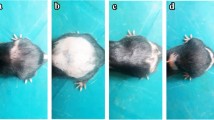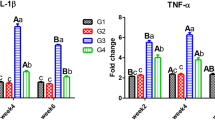Abstract
Arsenic (As) is an environmental pollutant with destructive effects on different body organs, including the testis. This work was aimed to assess the ameliorative role of caffeic acid (CA) against As-provoked testicular damage in mice. Twenty-four adult male mice (31 ± 9 g) were randomly allocated to four equal groups. The first group served as control and was provided basal diet and tap water. Animals in the second group received water containing 200 ppm arsenite. The third group of mice received CA (60 mg/kg body weight; i.p.) during exposure to arsenite. Animals in the fourth group received CA. At the end of the experiment period (21 days), blood and testicular tissue sampling was done for biochemical and histopathological assessments. The results showed a significant decline of testicular ferric reducing antioxidant power (FRAP), superoxide dismutase, and glutathione peroxidase (GPx), as well as plasma concentrations of testosterone and dihydrotestosterone in As-treated mice compared to controls (p < 0.05). A significant increase in testicular malondialdehyde was also detected in group 2 relative to controls. Moreover, As exposure resulted in some morphological and histopathological alterations of the testis, including hyperemia, reduced tubular diameter and thickness of epithelial cell layers of seminiferous tubules, and Leydig cell necrosis. Simultaneous administration of CA plus As increased GPx, FRAP, testosterone, and dihydrotestosterone amounts and attenuated MDA levels as well as histopathological alterations to the levels that were not significantly different from those of the control group. These results indicate that caffeic acid can be suggested as an alleviative natural compound against As-induced damage in mice testes.





Similar content being viewed by others
References
Garcia MT, Duenas AH, Pampliega JP (2013) Hematological effects of arsenic in rats after subchronical exposure during pregnancy and lactation: the protective role of antioxidants. Exp Toxicol Pathol 65:609–614. https://doi.org/10.1016/j.etp.2012.06.004
Jang YC, Somanna Y, Kim H (2016) Source, distribution, toxicity and remediation of arsenic in the environment a review. Int J Appli Environ Sci 11:559–581. https://doi.org/10.5958/2230-732X.2015.00025.X
Ommati MM, Manthari RK, Tikka C, Niu R, Sun Z, Sabouri S, Zamiri MJ, Ahmadi HN, Ghaffari H, Heidari R, Wang J (2020) Arsenic-induced autophagic alterations and mitochondrial impairments in HPG-S axis of mature male mice offspring (F1-generation): a persistent toxicity study. Toxicol Lett 326:83–98. https://doi.org/10.1016/j.toxlet.2020.02.013
Kenyon EM, Hughes MF, Adair BM, Highfill JH, Crecelius EA, Clewell HJ, Yager JW (2008) Tissue distribution and urinary excretion of inorganic arsenic and its methylated metabolites in C57BL6 mice following subchronic exposure to arsenate in drinking water. Toxicol Appl Pharmacol 232:448–455. https://doi.org/10.1016/j.taap.2008.07.018
Elshawarby AM, Saleh HA, Attia AA, Negm EA (2014) Arsenic-induced toxicity in the endometrium of adult albino rat and the possible role of human chorionic gonadotropin hormone: a histological study. Egypt J Histol 37:327–338. https://doi.org/10.1097/01.EHX.0000446582.73701.1b
Jahan S, Iftikhar N, Ullah H, Rukh G, Hussain I (2015) Alleviative effect of quercetin on rat testis against arsenic: a histological and biochemical study. Syst Biol Reprod Med 61:89–95. https://doi.org/10.3109/19396368.2014.998350
Mehta M, Hundal SS (2016) Effect of sodium arsenite on reproductive organs of female Wistar rats. Arch Environ Occup Health 71:16–25. https://doi.org/10.1080/19338244.2014.927346
Souza ACF, Marchesi SC, Almeida D, Lima G, Ferraz RP, Santos FC, Machado Neves M (2016) Effects of sodium arsenite and arsenate in testicular histomorphometry and antioxidants enzymes activities in rats. Biol Trace Elem Res 171:354–362. https://doi.org/10.1007/s12011-015-0523-0
Tazari M, Baghshani H, Moosavi Z (2018) Effect of betaine versus arsenite-induced alterations of testicular oxidative stress and circulating androgenic indices in rats. Andrologia 50:e13091. https://doi.org/10.1111/and.13091
Birben E, Sahiner UM, Sackesen C, Erzurum S, Kalayci O (2012) Oxidative stress and antioxidant defense. World Allergy Organ J 5:9–19. https://doi.org/10.1097/WOX.0b013e3182439613
Reddy PS, Rani GP, Sainath SB, Meena R, Supriya C (2011) Protective effects of N-acetylcysteine against arsenic-induced oxidative stress and reprotoxicity in male mice. J Trace Elem Med Biol 25:247–253. https://doi.org/10.1016/j.jtemb.2011.08.145
Chang SI, Jin B, Youn P, Park C, Park JD, Ryu DY (2007) Arsenic-induced toxicity and the protective role of ascorbic acid in mouse testis. Toxicol Appl Pharmacol 218:196–203. https://doi.org/10.1016/j.taap.2006.11.009
Manna P, Sinha M, Sil PC (2008) Protection of arsenic-induced testicular oxidative stress by arjunolic acid. Redox Rep 13:67–77. https://doi.org/10.1179/135100008X259169
Das J, Ghosh J, Manna P, Sinha M, Sil PC (2009) Taurine protects rat testes against NaAsO2-induced oxidative stress and apoptosis via mitochondrial dependent and independent pathways. Toxicol Lett 187:201–210. https://doi.org/10.1016/j.toxlet.2009.03.001
Lotfi-Ghahramanloo M, Baghshani H (2016) Ameliorative effects of caffeic acid on lead accumulation and oxidative stress in lead-exposed mice. Zahedan J Res Med Sci 18(5):e6674. https://doi.org/10.17795/zjrms-6674
Pari L, Prasath A (2008) Efficacy of caffeic acid in preventing nickel induced oxidative damage in liver of rats. Chem Biol Interact 173:77–83. https://doi.org/10.1016/j.cbi.2008.02.010
Magnani C, Isaac VLB, Correa MA, Salgado HRN (2014) Caffeic acid: a review of its potential use in medications and cosmetics. Anal Methods 6:3203–3210. https://doi.org/10.1039/c3ay41807c
Tosovic J (2017) Spectroscopic features of caffeic acid: theoretical study. Kragujev J Sci 39:99–108. https://doi.org/10.5937/KgJSci173.9099T
Genaro-Mattos TC, Maurício ÂQ, Rettori D, Alonso A, Hermes-Lima M (2015) Antioxidant activity of caffeic acid against iron-induced free radical generation. A chemical approach. PLoS one 10:e0129963. https://doi.org/10.1371/journal.pone.0129963
Rodrigues JL, Araújo RG, Prather KLJ, Kluskens LD, Rodrigues LR (2015) Heterologous production of caffeic acid from tyrosine in Escherichia coli. Enzym Microb Technol 71:36–44. https://doi.org/10.1016/j.enzmictec.2015.01.001
Kilani-Jaziri S, Mokdad-Bzeouich I, Krifa M, Nasr N, Ghedira K, Chekir-Ghedira L (2017) Immunomodulatory and cellular anti-oxidant activities of caffeic, ferulic, and p-coumaric phenolic acids: a structure-activity relationship study. Drug Chem Toxicol 40:416–424. https://doi.org/10.1080/01480545.2016.1252919
Agunloye OM, Oboh G, Ademiluyi AO, Ademosun AO, Akindahunsi AA, Oyagbemi AA (2019) Cardio-protective and antioxidant properties of caffeic acid and chlorogenic acid: mechanistic role of angiotensin converting enzyme, cholinesterase and arginase activities in cyclosporine induced hypertensive rats. Biochem Pharmacol 109:450–458. https://doi.org/10.1016/j.biopha.2018.10.044
Xie J, Yang F, Zhang M, Lam C, Qiao Y, Xiao J (2017) Antiproliferative activity and SARs of caffeic acid esters with mono-substituted phenylethanols moiety. Bioorg Med Chem Lett 27:131–134. https://doi.org/10.1016/j.bmcl.2016.12.007
Yang SY, Hong CO, Lee GP, Kim CT, Lee KW (2013) The hepatoprotection of caffeic acid and rosmarinic acid, major compounds of Perilla frutescens, against t-BHP-induced oxidative liver damage. Food Chem Toxicol 55:92–99. https://doi.org/10.1016/j.fct.2012.12.042
Bispo VS, Dantas LS, Chaves Filho AB, Pinto IFD, Silva Rp DA, Otsuka FAM (2017) Reduction of the DNA damages, hepatoprotective effect and antioxidant potential of the coconut water, ascorbic and caffeic acids in oxidative stress mediated by ethanol. An Acad Bras Cienc 89:1095–1109. https://doi.org/10.1590/0001-3765201720160581
Arivarasu NA, Priyamvada S, Mahmood R (2012) Caffeic acid inhibits chromium(VI)-induced oxidative stress and changes in brush border membrane enzymes in rat intestine. Biol Trace Elem Res 148:209–215. https://doi.org/10.1007/s12011-012-9349-1.38
Guvvala PR, Sellappan S, Parameswaraiah RJ (2016) Impact of arsenic(V) on testicular oxidative stress and sperm functional attributes in Swiss albino mice. Environ Sci Pollut Res Int 18:18200–18210. https://doi.org/10.1007/s11356-016-6870-3
Xie Y, Trouba KJ, Liu J, Waalkes MP, Germolec DR (2004) Biokinetics and subchronic toxic effects of oral arsenite, arsenate, monomethylarsonic acid, and dimethylarsinic acid in v-Ha-ras transgenic (Tg.Ac) mice. Environ Health Perspect 112:1255–1263. https://doi.org/10.1289/txg.7152
Akram Z, Jalali S, Kalsoom O, Batool S, Shami SA (2018) A study on the effects of arsenic toxicity on oviduct histomorphology in the female rat. J Histotechnol 41:149–159. https://doi.org/10.1080/01478885.2018.1484330
Ellman GL (1959) Tissue sulphydryl group. Arch Biochem Biophys 82:70–77. https://doi.org/10.1016/0003-9861.(59)90090-6
Todorova I, Simeonova G, Kyuchukova D, Dinev D, Gadjeva V (2005) Reference values of oxidative stress parameters (MDA, SOD, CAT) in dogs and cats. Comp Clin Pathol 13:190–194. https://doi.org/10.1007/s00580-005-0547-5
Benzie IF, Strain JJ (1996) The ferric reducing ability of plasma (FRAP) as a measure of antioxidant power The FRAP assay. Anal Biochem 239:70–76. https://doi.org/10.1006/abio.1996.0292
Baltacioglu E, Akalin FA, Alver A, Deger O, Karabulut E (2008) Protein carbonyl levels in serum and gingival crevicular fluid in patients with chronic periodontitis. Arch Oral Biol 53:716–722. https://doi.org/10.1016/j.archoralbio.2008.02.002
Barangi S, Mehri S, Moosavi Z, Hayesd AW, Reiter RJ, Cardinali DP, Karimi G (2020) Melatonin inhibits benzo (a) pyrene-induced apoptosis through activation of the Mir-34a/Sirt1/autophagy pathway in mouse liver. Ecotoxicol Environ Saf 196:110556. https://doi.org/10.1016/j.ecoenv.2020.110556
Matboli M, Eissa S, Ibrahim D, Hegazy MG, Imam SS, Habib EK (2017) Caffeic acid attenuates diabetic kidney disease via modulation of autophagy in a high-fat diet/streptozotocin-induced diabetic rat. Sci Rep 7:1–12. https://doi.org/10.1038/s41598-017-02320-z
Lushchak VI (2012) Glutathione homeostasis and functions: potential targets for medical interventions. J Amino Acids 2012:1–26. https://doi.org/10.1155/2012/736837
Baltaci BB, Uygur R, Caglar V, Aktas C, Aydin M, Ozen OA (2016) Protective effects of quercetin against arsenic-induced testicular damage in rats. Andrologia 48:1202–1213. https://doi.org/10.1111/and.12561
Uygur R, Aktas C, Caglar V, Uygur E, Erdogan H, Ozen OA (2016) Protective effects of melatonin against arsenic-induced apoptosis and oxidative stress in rat testes. Toxicol Ind Health 32:848–859. https://doi.org/10.1177/0748233713512891
Ramanathan K, Balakumar BS, Panneerselvam C (2002) Effects of ascorbic acid and alpha-tocopherol on arsenic-induced oxidative stress. Hum Exp Toxicol 21:675–680. https://doi.org/10.1191/0960327102ht307oa
Sankar P, Gopal Telang A, Kalaivanan R, Karunakaran V, Manikam K, Sarkar SN (2015) Effects of nanoparticle-encapsulated curcumin on arsenic-induced liver toxicity in rats. Environ Toxicol 30:628–637. https://doi.org/10.1002/tox.21940
Radabaugh TR, Aposhian HV (2000) Enzymatic reduction of arsenic compounds in mammalian systems: Reduction of arsenate to arsenite by human liver arsenate reductase. Chem Res Toxicol 13:26–30. https://doi.org/10.1021/tx990115k
Nardini M, D'Aquino M, Tomassi G, Gentili V, Di Felice M, Scaccini C (1995) Inhibition of human lowdensity lipoprotein oxidation by caffeic acid and other hydroxycinnamic acid derivatives. Free Radic Biol Med 19:541–552. https://doi.org/10.1016/0891-5849(95)00052-Y
Turner TT, Lysiak JJ (2008) Oxidative stress: a common factor in testicular dysfunction. J Androl 29:488–498. https://doi.org/10.2164/jandrol.108.005132
Jana K, Jana S, Samanta PK (2006) Effects of chronic exposure to sodium arsenite on hypothalamo-pituitary-testicular activities in adult rats: possible an estrogenic mode of action. Reprod Biol Endocrinol 4:9–21. https://doi.org/10.1186/1477-7827-4-9
Fouad AA, Al-Sultan AI, Yacoubi MT (2011) Coenzyme Q10 counteracts testicular injury induced by sodium arsenite in rats. Eur J Pharmacol 655:91–98. https://doi.org/10.1016/j.ejphar.2010.12.045
Sanghamitra S, Hazra J, Upadheyay SN, Singh KR (2008) Arsenic induced toxicity on testicular tissue of mice. Indian J Physiol Pharmacol 52:84–90
Sharma G, Kumar M (2014) Arsenic induced histological alterations in testis of Swiss albino mice and protection by Chlorophytum borivilianum. Asian Pac J Reprod 3:282–287. https://doi.org/10.1016/S2305-0500(14)60040-3
Acknowledgments
This work was supported by a grant from Ferdowsi University of Mashhad, Mashhad, Iran (grant No. 49393).
Author information
Authors and Affiliations
Corresponding author
Additional information
Publisher’s Note
Springer Nature remains neutral with regard to jurisdictional claims in published maps and institutional affiliations.
Rights and permissions
About this article
Cite this article
Dehdashti Moghadam, M., Baghshani, H., Ghodrati Azadi, H. et al. Ameliorative Effects of Caffeic Acid Against Arsenic-Induced Testicular Injury in Mice. Biol Trace Elem Res 199, 3772–3780 (2021). https://doi.org/10.1007/s12011-020-02518-9
Received:
Accepted:
Published:
Issue Date:
DOI: https://doi.org/10.1007/s12011-020-02518-9




